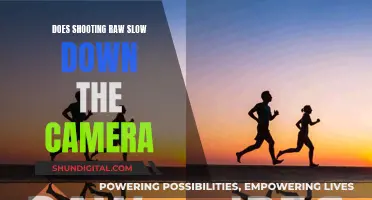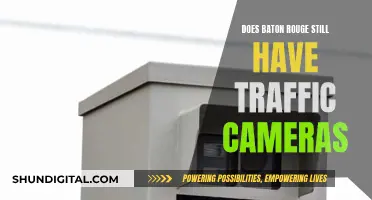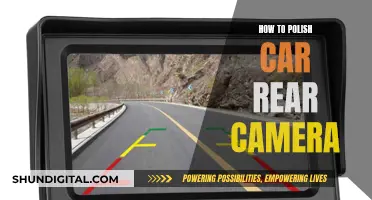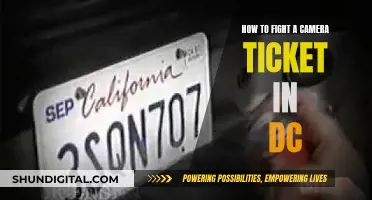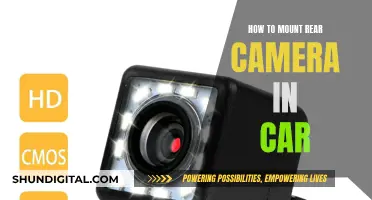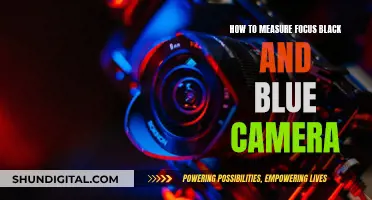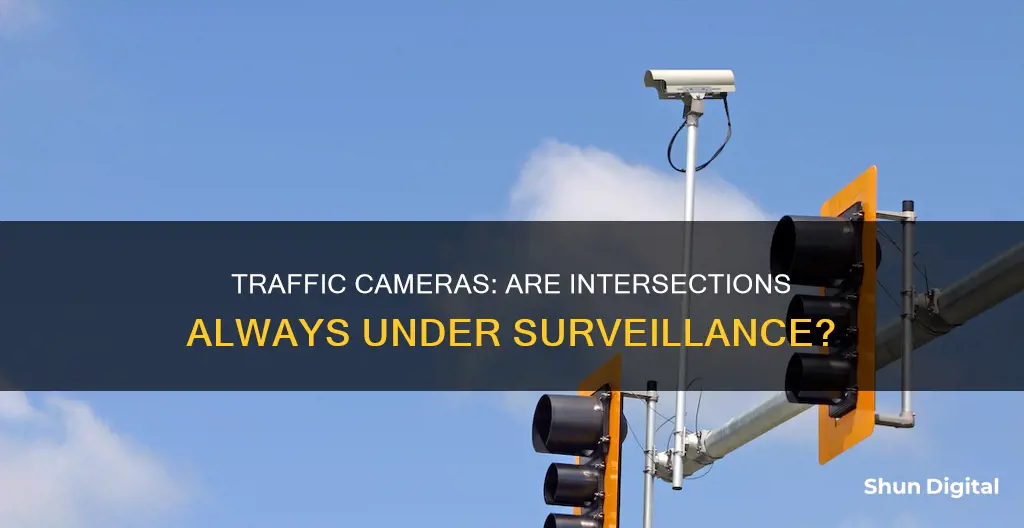
Traffic cameras are an important tool for enforcing traffic laws and ensuring road safety. They are typically mounted on traffic lights or signals at busy intersections to monitor traffic flow and improve road safety and traffic congestion. However, not all intersections have traffic cameras due to the high costs of installation, maintenance, and operation. These cameras are more commonly found in urban areas with high traffic volumes and are less common in rural areas. While traffic cameras play a crucial role in road safety, their effectiveness in reducing accidents and improving traffic flow varies.
| Characteristics | Values |
|---|---|
| Purpose | To enforce traffic laws and ensure road safety |
| Installation | Expensive to install, so they are usually found in busy areas with high volumes of traffic |
| Functionality | They detect vehicles approaching and moving through intersections using sensors and provide real-time video |
| Evidence | Red light cameras capture still images, while intersection cameras provide video evidence that can be used in car accident claims |
| Ticketing | Red light cameras can automatically issue tickets to drivers who run red lights |
| Notification | It is difficult to know if a traffic camera has caught you unless you observe its flash |
| Privacy | Not all network-connected cameras are monitored by law enforcement, and the feeds are not recorded in real-time |
What You'll Learn

Traffic cameras improve road safety
Traffic cameras are an effective tool for improving road safety. They act as a deterrent for speeding and red-light running, not only for the vehicle being monitored but also for other road users, including vulnerable individuals like cyclists and pedestrians. The mere presence of these cameras and the belief that one will be caught and fined are often enough to prevent people from engaging in unsafe driving behaviours.
Research from various countries supports the positive impact of traffic cameras on road safety. A worldwide review of studies found that speed cameras led to a reduction of 11% to 44% in fatal and serious injury crashes. Similarly, the UK Department for Transport estimated a 22% reduction in personal injury collisions and a 42% decrease in fatalities or severe injuries at camera sites. An evaluation report from New South Wales, Australia, further reinforces this, revealing a 90% reduction in fatal crashes near speed camera sites.
In addition to speed and red-light cameras, bus lane enforcement cameras and noise pollution cameras also contribute to road safety. Bus lane cameras monitor the use of bus lanes by unauthorised vehicles, while noise cameras enforce compliance with vehicle noise limits, addressing mass complaints about excessive vehicle noise.
While some may argue that traffic cameras invade privacy or are primarily used for revenue generation, the body of evidence suggests that they play a crucial role in deterring unsafe driving behaviours and reducing the severity of collisions, ultimately enhancing road safety.
Traditional Cameras: Still Relevant or Obsolete?
You may want to see also

Footage is used as evidence in car accident claims
Traffic cameras are often used to monitor and manage traffic flow and road safety. While not all intersections have traffic cameras, the footage from these cameras can be used as evidence in car accident claims. This evidence can be used to determine who was at fault and the extent of the damage caused. However, obtaining traffic camera footage can be challenging as these cameras are typically used for real-time monitoring and the footage may not be stored for future retrieval.
Video evidence is often valuable in car accident claims as it provides an unbiased and accurate account of the incident. This evidence can be used by insurance companies and attorneys to determine liability and calculate appropriate compensation. In some cases, insurance companies may conduct their own investigations and aggressively pursue recorded surveillance to avoid paying large settlements. It is important for those involved in accidents to be transparent and honest when filing claims to avoid any issues with insurance companies.
There are various types of video footage that can be used as evidence in car accident claims. This includes footage from residential and business security cameras, dashboard cameras, and even eyewitnesses' smartphones. Attorneys can help accident victims gather and analyse this evidence, including requesting preservation of relevant footage to ensure it is not tampered with or deleted.
While traffic camera footage can be useful, it is not always essential for a successful claim. Other types of evidence, such as witness testimonies, police reports, and medical records, can also be used to support a claim. Additionally, insurance companies may have their own internal processes and professionals to assess evidence and determine compensation. It is recommended to consult with a personal injury attorney who can guide individuals through the complex process and protect their rights.
The Most Common Camera Focusing Method Explained
You may want to see also

Red light cameras are automatic ticket-issuing systems
The red light camera system is triggered when a vehicle passes over a sensor in the intersection while the light is red. The cameras take pictures that usually show the vehicle's license plate and the driver. Many camera systems also take video footage of the vehicle driving through the red light. These cameras are fairly accurate, but sometimes they are falsely triggered. To prevent errors, an officer or technician generally reviews the photos and videos before any tickets are issued. If a violation is confirmed, the registered owner of the vehicle will receive a ticket in the mail.
In most states, it is the driver, not the owner, who is liable for the violation. Many states allow owners who receive tickets to submit a sworn statement that they were not driving at the time of the incident, which typically results in the dismissal of the ticket. It's important to note that the existence of photos and videos usually confirms that a violation occurred, but occasionally, mistakes are made, and drivers can use this evidence to their advantage to get a ticket dismissed.
The laws of some states require signs to be posted that inform drivers of the presence of red light cameras at an intersection. Drivers cited for violations at intersections without the required signage may have a valid defence against the ticket.
Blind Surveillance Cameras: Quick and Easy Methods for Privacy
You may want to see also

Traffic cameras are not always recording in real-time
The primary purpose of traffic cameras that do not record is real-time traffic management and monitoring. These cameras are used by transportation departments and law enforcement agencies to manage traffic flow and respond to incidents as they happen. By tracking live traffic conditions at key locations, they can make adjustments to improve traffic flow and quickly respond to collisions or other incidents.
However, the lack of recorded footage can present challenges when trying to access video evidence for car accident claims or legal proceedings. While some agencies may occasionally save footage, it is often difficult to obtain and requires a subpoena or a formal request. Even with a subpoena, there is a low probability of successfully accessing the specific footage of an accident, as it requires knowledge of the exact location and time of the incident.
Additionally, the storage duration of traffic camera footage varies. Some agencies may store recorded video for more than a year, while others may overwrite or delete footage within 24 to 72 hours due to limited storage capacity. Therefore, it is essential to make requests for footage as soon as possible after an incident occurs.
Traffic Cameras in California: Are They Legal?
You may want to see also

Traffic cameras are positioned differently to traffic sensors
Traffic cameras are distinct from traffic sensors in several ways, including their positioning, purpose, and functionality. While both play a crucial role in traffic management, their differences are significant.
Traffic cameras are typically installed along major roads, such as highways, freeways, expressways, and arterial roads. They are often mounted on high poles, masts, or streetlights to capture a comprehensive view of the traffic flow. In contrast, traffic sensors are usually positioned on top of traffic signals or mounted high on light poles above roadways. This strategic placement allows them to monitor traffic signals and collect data for signal timing adjustments.
The primary purpose of traffic cameras is to observe and monitor vehicular traffic. They provide real-time video footage to monitoring centres, enabling dispatchers to respond quickly to incidents, collisions, or safety issues. On the other hand, traffic sensors have a different function. They are used to measure traffic flow, collect traffic data, and determine traffic light timing. By analysing the data collected by traffic sensors, transportation departments can make informed decisions about signal timing to optimise traffic flow.
In terms of functionality, traffic cameras operate by continuously capturing video footage, often in full motion. This helps in observing traffic conditions and identifying any disruptions or incidents. Traffic sensors, on the other hand, utilise different technologies, such as radar or laser sensors, to collect data on traffic volume, speed, and occupancy. This data is then analysed to adjust signal timing and improve traffic flow.
The positioning, purpose, and functionality of traffic cameras and traffic sensors complement each other in managing traffic flow and ensuring road safety. While traffic cameras focus on observation and incident response, traffic sensors contribute to data-driven decisions for signal timing and traffic management.
Dash Camera: An Eye on the Road
You may want to see also
Frequently asked questions
No, not all intersections have traffic cameras. They are usually installed at busier intersections where there is a high volume of traffic.
These are traffic monitoring cameras owned by the Department of Transportation. They are used to help the flow of traffic and provide a live stream for traffic engineers, law enforcement, cities, and counties.
No, red light cameras only capture still images of vehicles that enter an intersection against a red light, which can be used as evidence for potential traffic violations.
Yes, some cameras on traffic lights are specifically designed to enforce traffic laws by issuing tickets to drivers who run red lights.


